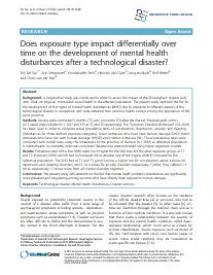Does exposure type impact differentially over time on the development of mental health disturbances after a technological disaster?
Background: A longitudinal study was conducted in order to assess the impact of the Ghislenghien disaster (July
30th, 2004) on physical, mental and social health in the affected population. The present study explored the risk for
the development of four types of mental health disturbances (MHD) due to exposure to different aspects of this
technological disaster in comparison with data obtained from previous health surveys among the population of the
same province.
Methods: Surveys were conducted 5 months (T1) and 14 months (T2) after the disaster. Potential adult victims
(.15 years) were included (n = 1027 and 579 at T1 and T2 respectively). The gSymptom Checklist-90-Revisedh (SCL-90-R)
has been used in order to compute actual prevalence rates of somatization-, depression-, anxiety- and sleeping
disturbances for three defined exposure categories: direct witnesses who have seen human damage (SHD), direct
witnesses who have not seen human damage (NSHD) and indirect witnesses (IW). Those prevalence rates were
compared with overall rates using the inhabitants of the province of Hainaut (n = 2308) as reference population.
A mental health co-morbidity index was computed. Relative risks were estimated using logistic regression models.
Results: Prevalence rates of the four MHD were much higher for the SHD than for the other exposure groups, at T1
and T2. Moreover, NSHD and IW had no increased risk to develop one of the 4 types of MHD compared to the
reference population. The SHD had at T1 and T2 good 5-times a higher risk for somatization, about 4-times for
depression and sleeping disorders, and 5- to 6-times for anxiety disorders respectively. Further, they suffered 13
times, respectively 17 times more from all mental disorders together.
Conclusions: The present study calls attention to the fact that mental health problems disturbances are significantly
more prevalent and long-lasting among survivors who have directly been exposed to human damage.
Geachte bezoeker,
De informatie die u nu opvraagt, kan door psychotraumanet niet aan u worden getoond. Dit kan verschillende redenen hebben,
waarvan (bescherming van het) auteursrecht de meeste voorkomende is. Wanneer het mogelijk is om u door te verwijzen naar de bron
van deze informatie, dan ziet u hier onder een link naar die plek.
Als er geen link staat, kunt u contact opnemen met de bibliotheek,
die u verder op weg kan helpen.
Met vriendelijke groet,
Het psychotraumanet-team.
Reference:
Erik De Soir, Ann Versporten, Emmanuelle Zech, Herman Van Oyen, Jacques Mylle, Rolf Kleber, & Onno van der Hart | 2015
In: Archives of Public Health, ISSN 0778-7367 | 73 | 20
http://www.biomedcentral.com/content/pdf/s13690-015-0066-z.pdf
In: Archives of Public Health, ISSN 0778-7367 | 73 | 20
http://www.biomedcentral.com/content/pdf/s13690-015-0066-z.pdf


